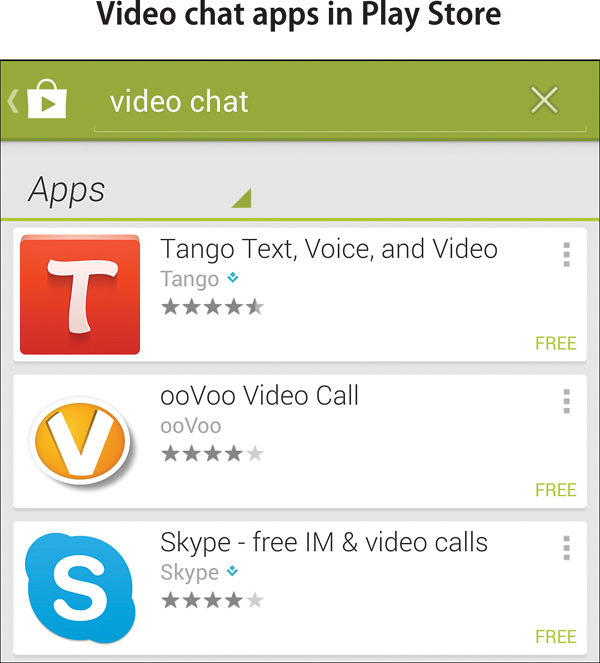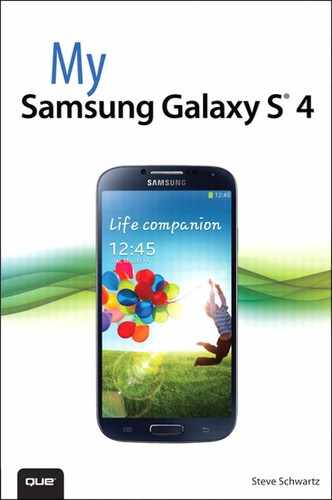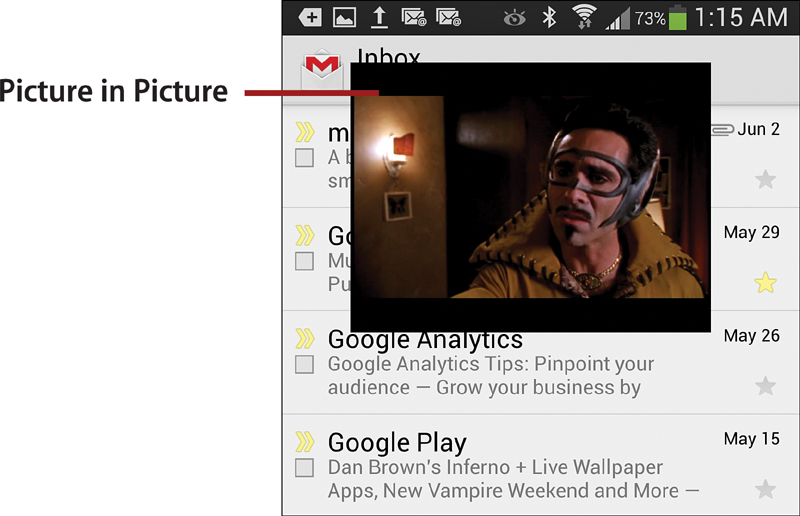14. Watching and Creating Videos
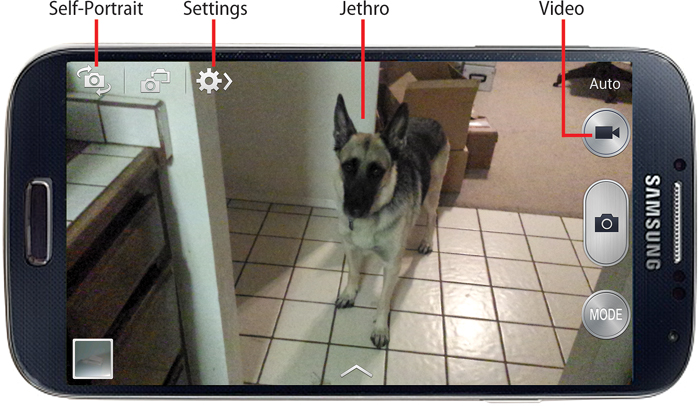
In this chapter, you find out how to use your phone for viewing videos from a variety of sources, as well as for shooting, trimming, and sharing your own videos. Topics include the following:
→ Streaming video over the Internet to your phone
→ Using the Video app to play videos
→ Converting DVD videos for playback on your phone
→ Recording videos with the rear and front cameras
→ Using dedicated video chat apps
With the pair of cameras on the Galaxy S 4, you can record videos of yourself, others, or anything that moves. The phone’s high-resolution screen makes it ideal for viewing those videos, as well as movies and TV shows that you’ve extracted from DVDs, rented or purchased online, or streamed to special video apps.
Streaming Video to the Phone
Streaming video is sent to your phone as a stream of data that plays as it’s transmitted. Unlike material that you download, streaming requires an active Internet connection and doesn’t result in a file that’s permanently stored on your phone. If you want to watch the same video again, you need to stream it again. You can access streaming video through dedicated apps such as YouTube or by clicking web page links.
Streaming with a Dedicated App
The two most common classes of streaming video apps are subscription-based and free. Examples of subscription-based apps include Netflix, HBO Go, and Max Go (for Cinemax). To access Netflix movies, you must be a Netflix streaming subscriber. To access HBO or Cinemax, you must currently receive HBO or Cinemax through a supported satellite or cable TV provider.
After installing and launching one of these apps, you sign in with the username and password that you use to log on to www.netflix.com, www.hbogo.com, or www.maxgo.com. (In the case of subscription TV services, your username and password are generally the ones you use for your cable or satellite provider’s website.) The apps are designed to remember this login information, so future launches won’t require you to reenter it.
Many other apps for streaming video don’t require a subscription for basic access. Examples include YouTube, MTV News, and Adult Swim.

Depending on how the streaming app was designed, when you select a video to view, it plays in a dedicated player or in Video, an app that’s preinstalled on the Galaxy S 4. The controls most players provide are similar to the ones in Video. In the Adult Swim player, for example, you can tap the screen at any time to display the playback controller and then do any of the following:
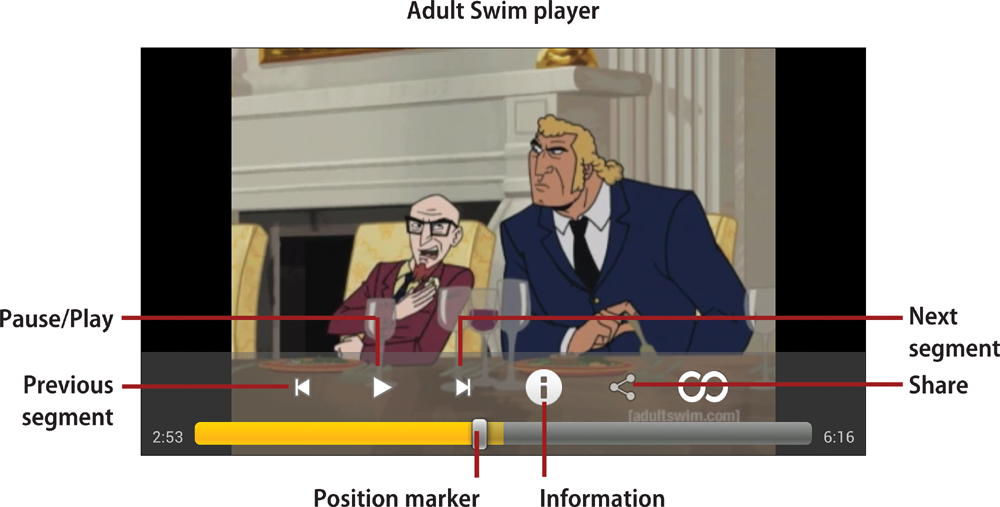
• To start/restart or pause playback, tap the Pause/Play button.
• To jump forward or backward within the current video, drag the position marker to the approximate spot.
• If the current video is split into multiple segments, you can go to the next or previous segment by tapping a segment button.
• To review information about the video you’re watching, tap the Information button.
• To share the video with others, tap the Share button and choose a sharing option from the pop-up menu.
• To adjust the playback volume, press the volume control on the left side of the phone.
• To exit the current video, press the Back key.
• Press the Menu key at any time to assist in your search for videos, clips, games, and scheduling information.
Streaming from Web Pages
Video clips are embedded in many web pages. When viewed in the Internet or Chrome app, these clips play in a similar manner to what you’d see in a computer browser—although the controls might be different. For example, some embedded clips display only a progress bar. However, if you search carefully, you might find a Full Screen icon or similarly worded link that enlarges the video and adds normal playback controls.

Playing Videos with the Video App
Regardless of whether a video was downloaded, bundled with or converted from a DVD, sent by a friend, or rented or purchased online, all compatible videos stored on your phone play using the Video app.
Technically Speaking
The Video app is not the app that actually plays your videos; it’s Video Player—a linked app, but one that has no shortcut in Apps. When you want to return from the Home screen or another app to continue viewing a paused video, hold down the Home key to see the list of active and recently run apps. You’ll see that both Video and Video Player are listed. If you tap Video Player, playback resumes. Tapping Video takes you to the Video app launch screen rather than to your video.
1. From the Home screen, tap Apps, followed by Video.
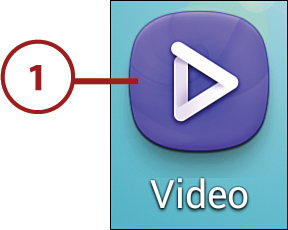
2. To play a video that’s stored on your phone, select the video by tapping its title or thumbnail. (You can find videos that you’ve created or manually added to the phone by selecting the Personal tab. Select the Download tab to see videos that you’ve rented or purchased online.)
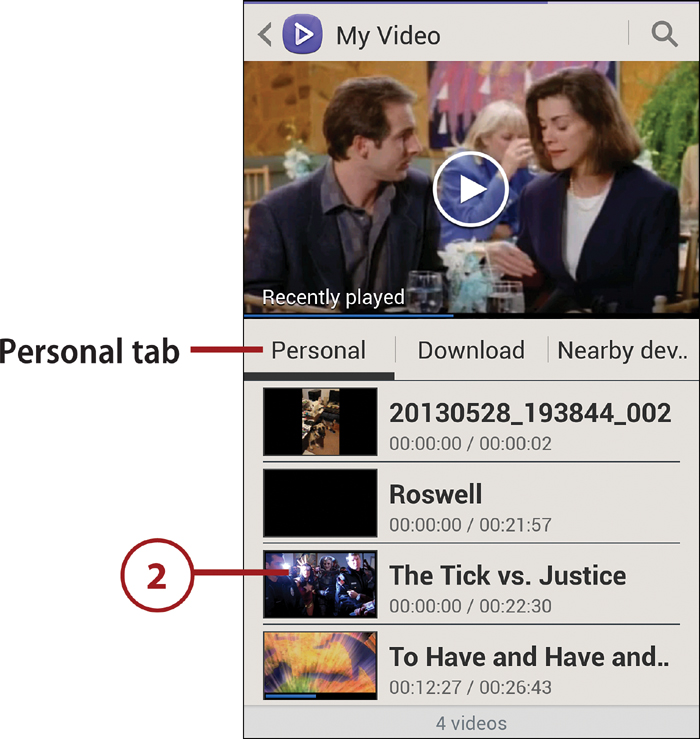
To make it easier to find the video that you want to watch, your video collection can be displayed as live thumbnails, as a list, or organized by the folders in which videos are stored. Press the Menu key, tap View As, and select an option. If you have many videos, you can specify a different sort order for the thumbnails or list by pressing the Menu key and tapping Sort By.
You can also select a video in Gallery, My Files, or another app. Doing this launches Video Player, skipping steps 1 and 2. Tap the Play icon to play the selected movie or clip.
3. The controller appears and the video begins to play. Rotate the screen to the desired orientation: landscape or portrait.
4. While playing the video, you can tap the screen to display the controller and then do any of the following:
• To start/restart or pause playback, tap the Pause/Play button.
• Tap the Video Size icon to change the way the video is sized to fit the screen. Depending on how the video was encoded and the display type for which it was intended, some sizes may stretch the image in one direction, and others may clip the image horizontally or vertically to fit. Tap the icon repeatedly to see all display options.
• To jump forward or backward in the current video, drag the position marker to the approximate spot.
• Tap the Rewind button to jump to the beginning of the current video or, if you’re at the beginning, to the previous video in the list. Press and hold the Rewind button to scroll backward through the current video; the longer you hold the button, the faster it scrolls.
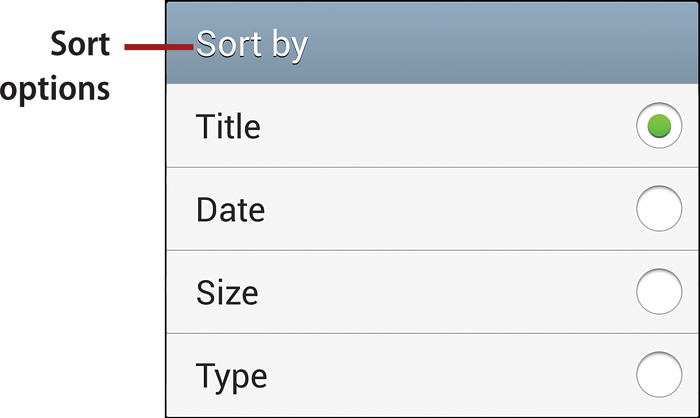
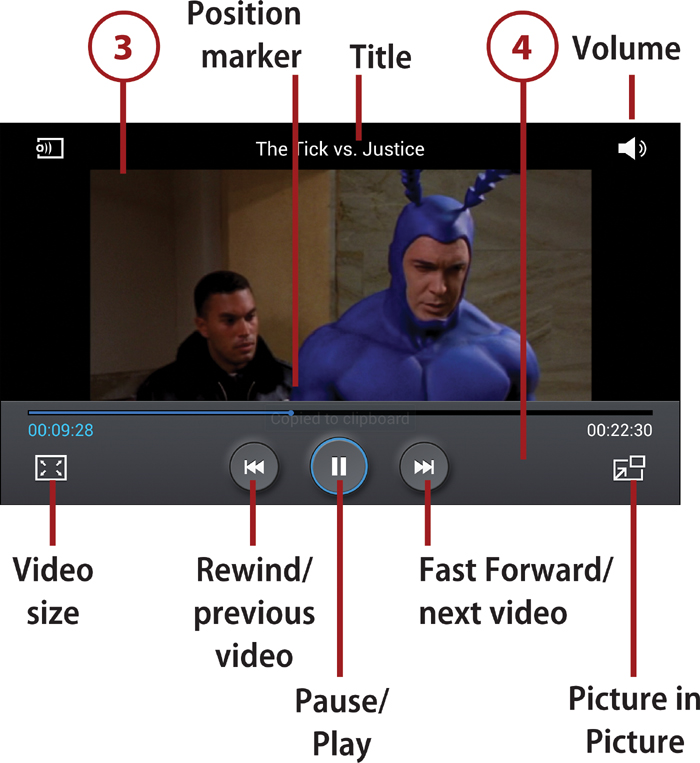
• Tap the Fast Forward button to jump to the next video. Press and hold the Fast Forward button to scroll forward through the current video; the longer you hold the button, the faster it scrolls.
• To adjust playback volume, tap the Volume icon and drag the slider that appears. (You can also change the volume by pressing the Volume control on the left side of the phone.)
• To leave the current video, press the Back key twice. To exit Video, press the Home key.
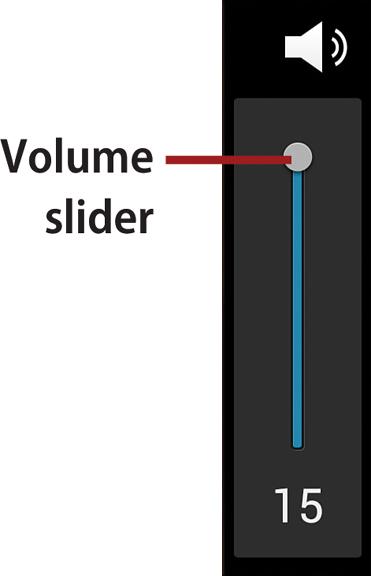
Smart Pause
If Smart Pause (a new Smart Screen system setting) is enabled, you can pause the current video by turning your eyes away from the screen. When you’re ready to resume, face the screen again.
To enable or disable Smart Pause, open Settings, select the My Device tab, tap Smart Screen, and tap the Smart Pause check box. Smart Pause and the other Smart Screen features work by detecting the presence of your eyes. If you wear glasses, you may have better luck with the Smart Screen features if you remove your glasses.
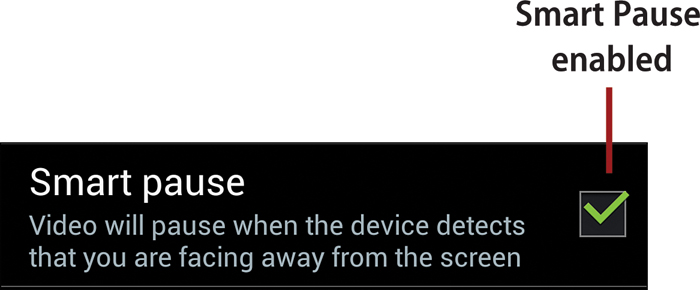
Using the Video Menu
On Video’s main screen, you can press the Menu key to choose from these commands:

• Scan for Nearby Devices. Scan for eligible devices within range with which media can be shared.
• Sort By, View As. See “Video Selection Assistance,” earlier in this section.
• Share Via. Transmit the video to others (Messaging, Email, and Gmail) or another device (Bluetooth and Wi-Fi Direct), or post it on a social networking or chat site (YouTube, ChatON, Google+, and Facebook). Note that many videos are too large to be shared via text messaging, email, or Gmail.
• Delete. Delete unwanted videos that are stored on the phone. Tap the check box of each video that you want to delete, tap Done, and tap OK in the confirmation dialog box that appears. (To delete an individual video, you can press and hold the video’s thumbnail or name, tap Delete, and then tap OK in the confirmation dialog box.)
• Edit. Launch Video Editor to create a video by combining photos and videos. You can add themes, music, voiceovers, and special effects. (If Video Editor isn’t installed, choosing this command launches Samsung Apps so you can download and install the app.)
• Auto Play Next. When enabled, this option causes Video to automatically play the next video in sequence when the current one finishes.
• Help. Review instructions for using Samsung Hub.
• Settings. Change settings for accessing and using Samsung Hub.
If you press the Menu key while watching a video, the following additional commands appear:
• Chapter Preview. Displays thumbnails representing breakpoints in the video. When you tap a thumbnail, the video resumes at that point.
• Via Bluetooth. Transmit the audio to a paired Bluetooth headset.
• Video Auto Off. Like the sleep timer on a TV, choose this command to automatically end video playback after a specified period of time or when the current video ends.
• Details. Display information about the video, such as its file format, resolution, and size.
Converting DVD Videos for Playback on the Phone
You can use many programs to extract video content from DVDs for playback on the Galaxy S 4 and other devices. The following task shows how to extract video using DVDFab/DVD Ripper, a DVD-to-mobile conversion utility for Windows and Mac OS X from www.dvdfab.com. Each extracted movie or TV show results in a single MPEG-4 (.mp4) file that you can view with the Video app.
Which Version Should I Use?
Currently, there are two versions of the DVDFab line of products: the older DVDFab 8 QT and the new DVDFab 9. Both are available as free 30-day trials. If you decide to purchase a license for DVDFab, you are entitled to use both versions. As an example of converting DVD videos for playback on your phone, the following task employs DVDFab 9.
1. Launch DVDFab on your computer. If the program doesn’t go directly to its main screen, click the Ripper icon on the splash screen.

2. Select the Ripper tab. Ensure that the selected profile that will be used to convert the video is correct. If so, go to step 4.
3. To change profiles, click the current profile name. In the dialog box that appears, select the Device tab, select Samsung in the scrolling list, select the Galaxy S4 profile, and click OK.
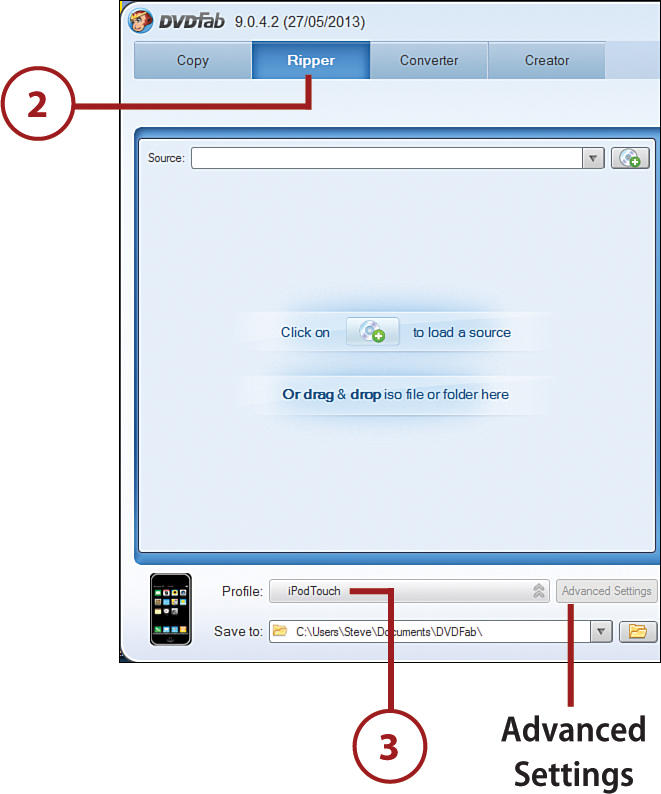
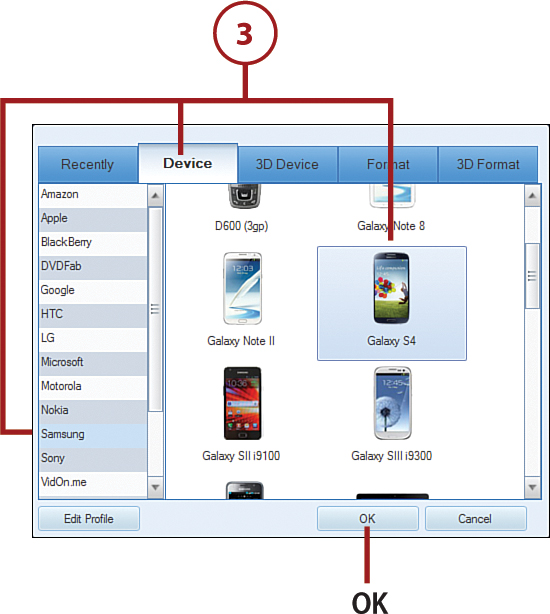
4. Insert the DVD that contains the material you want to extract. Wait for the program to scan and analyze the DVD’s file structure.

5. Select the material that you want to convert to videos for the phone by doing one of the following:
• If this is a movie DVD, the movie is automatically selected. (Generally, the movie will have the longest Play Time of the items on the DVD.)
• If this is an episodic DVD (containing multiple episodes of a television show, for example), click the check box of each episode that you want to convert. The application analyzes each checked episode; each results in a separate video.
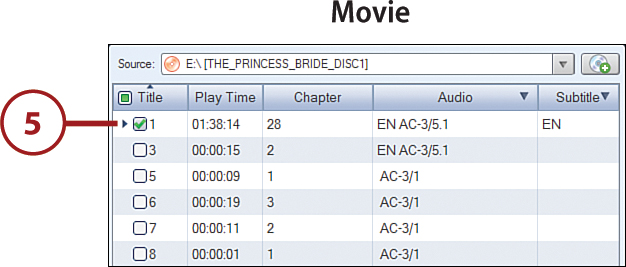

Using the Preview Window
Regardless of a DVD’s contents, you can preview each movie, episode, and other material (such as bloopers and deleted scenes) in the Preview window. Previewing can ensure that you’ve selected the correct video(s) and appropriate audio. Select a video to preview by clicking to the left of its number in the Title column, select the Preview tab, and click Play.
6. For each checked item, select an audio option. Normally, the recommended option will be correct. You can preview the material in the Preview window to ensure that you’ve chosen normal dialogue rather than the director’s commentary.
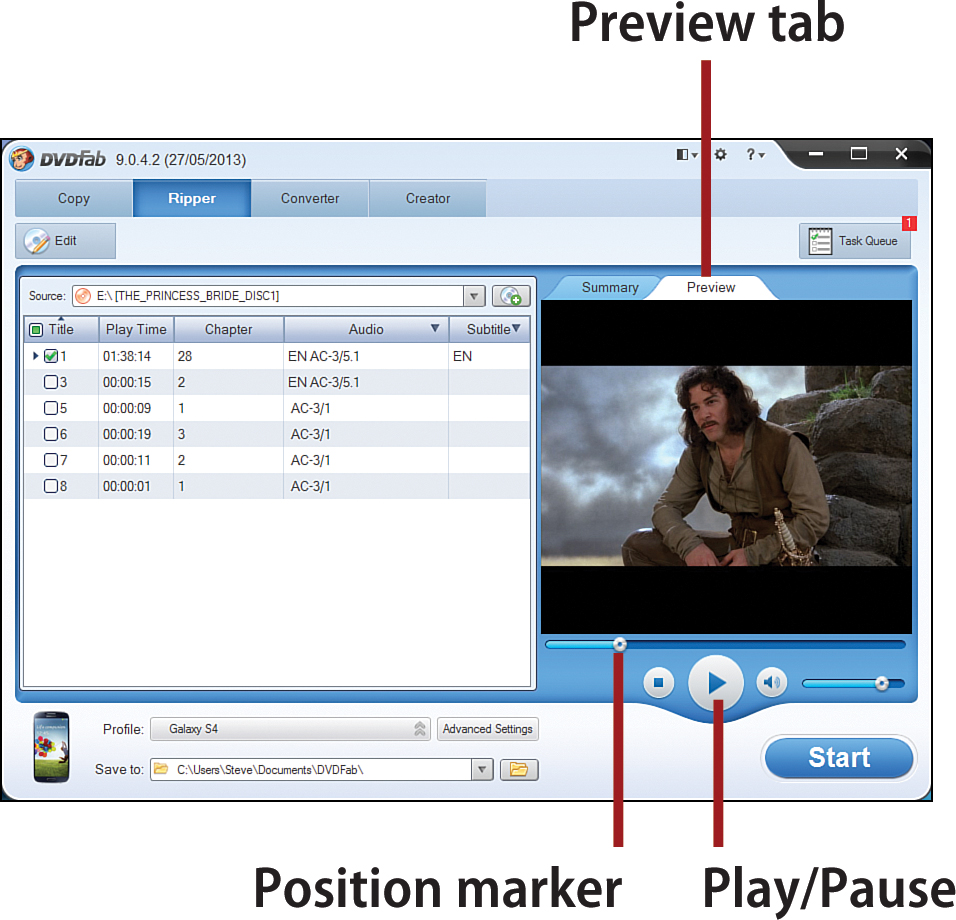
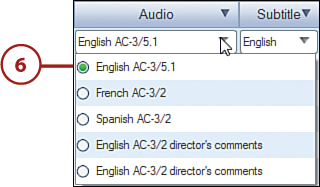
7. For each checked item, you can enable or disable subtitles (if the disk includes them). Select a subtitle language, and do one of the following:
• To disable normal subtitles, ensure that Display Only Forced Subtitle is checked. Subtitles appear only when an actor is momentarily speaking in a foreign language.
• To display subtitles throughout the video, remove the check mark from Display Only Forced Subtitle.
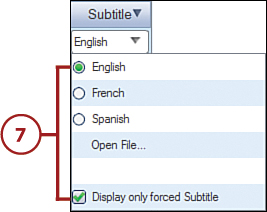
8. Optional: You can review or change the settings for resolution and other options for each movie, episode, and clip that you’re extracting. Click the Advanced Settings button (to the right of the profile) to review the current settings in the Video, Audio, Subtitle, and Information tabs of the window that appears. Otherwise, if you want to use the default settings, skip to step 14.
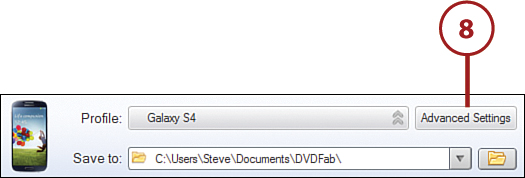
Episode Settings
If you’re converting multiple TV episodes or several items from a movie DVD, each can have different settings—although, you’ll generally want them all to be the same. To change settings for an episode or movie item, select it by clicking to the left of its Title number, and then make the changes. To ensure consistency, be sure to apply these same settings to every episode or selected item.
9. Video. You can change Encoding Method and/or Video Quality to improve the visual quality of the video or reduce the size of the video output file.
• Encoding Method can be 1- or 2-pass. The latter improves the quality but increases the time required to perform the encoding because it makes two passes through the source video.
• Changes in Video Quality (Small Size, Normal, and High Quality) are reflected in Bit Rate and Output Size. The higher the Video Quality setting, the higher the bit rate (quality) and the larger the file size.

Can You Tell the Difference?
As an experiment, you might try encoding the same movie at the three Video Quality settings and see if you can detect the difference. If you can’t or you’re willing to accept a small sacrifice in quality, smaller is better because you can fit more videos on your S 4. For example, when encoding the movie shown in this example, the High Quality file size is almost twice that of the Small Size file.
10. Audio. Set audio quality/clarity by choosing a Sample Rate and Bit Rate. Higher numbers yield higher-quality audio. (Available Bit Rate options are profile-dependent.) After conversion, if you notice that the playback audio is unusually loud or quiet, you can repeat the conversion with an appropriate change in the Volume setting.

11. Subtitle. Direct Render to Video embeds any subtitle text into the video. Because most video players can’t toggle subtitles on and off (as DVD players can), rendering them as part of the video is a logical solution. If you disabled subtitles in step 7, this setting is irrelevant.

12. Information. You can edit the File Name and/or Title.
• The filename doesn’t need to be in capital letters or end in .Title#, and it can contain spaces. Avoid using special characters, such as slashes and colons.
• The Title is the text that identifies the movie or video when it’s listed in Video and other players. Edit it to something more descriptive. In this example, I changed both the filename and title to the actual title: The Princess Bride.
13. When you finish reviewing settings, click OK to close the Advanced Settings window.
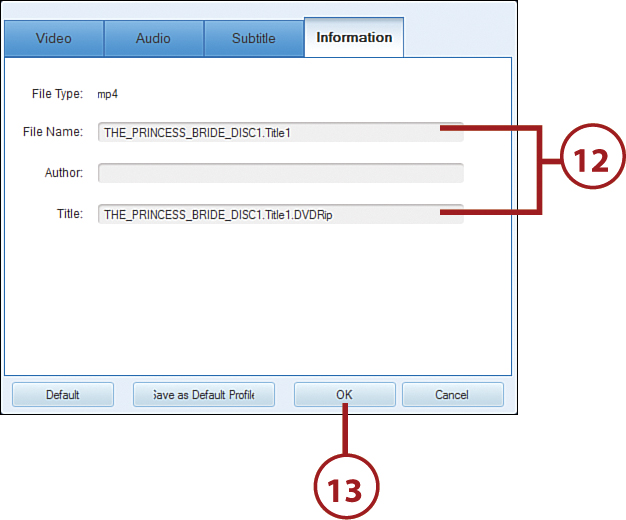
14. The Save To box at the bottom of the window shows the path (diskfolder) where the resulting video file will be saved on your computer. To pick a different location, click the down arrow to the right to specify a location you’ve previously used or click the folder icon to browse for a new location.
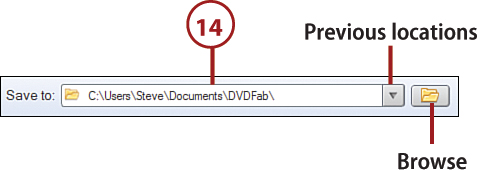
15. Convert the selected video(s) by clicking the Start button.

When you finish extracting videos, transfer them to your phone using any of the file-transfer techniques described in Chapter 15. The new files will appear in the Video file list.
Recording Videos with the Phone
Using your phone’s cameras, you can create movies that are suitable for posting on websites, emailing to friends, and playing on your phone or a flat-screen TV.
1. Launch Camera by doing one of the following:
• Tap a Camera shortcut on the Home screen.
• On the Home screen, tap Apps and then Camera.
• On the lock screen, slide the Camera icon up (if present).
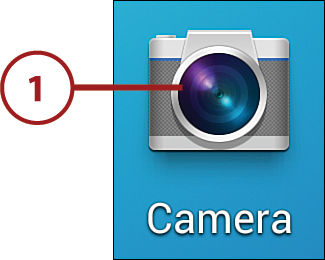
2. Decide whether to shoot the video in portrait or landscape. Rotate the phone to the proper orientation.
3. Optional: To switch between the rear-facing and front-facing cameras, tap the Self Portrait icon.
When You’re in a Rush
You won’t always have time to leisurely set options before you begin recording. If you’re in a hurry to capture something that’s happening right now, you can often make do by simply launching Camera, rotating the phone to the appropriate orientation, and pressing the Video button.
4. Check the current video settings. Note that most are for photos and have no effect when shooting a video. However, you should pay attention to these settings:
• Recording Mode. Tap the Settings icon to reveal the Quick Settings, tap the Recording Mode icon, and select a setting from the menu that appears. Use Normal for a standard recording and Limit for MMS for a video that you want to attach to a multimedia (MMS) message. For a description of the other settings, tap the i (Information) button.
• Video Size and Video Stabilization. To set these options, tap the Settings icon twice, and select the Video tab.
Enable Video Stabilization to reduce the effect of camera shake during recording.
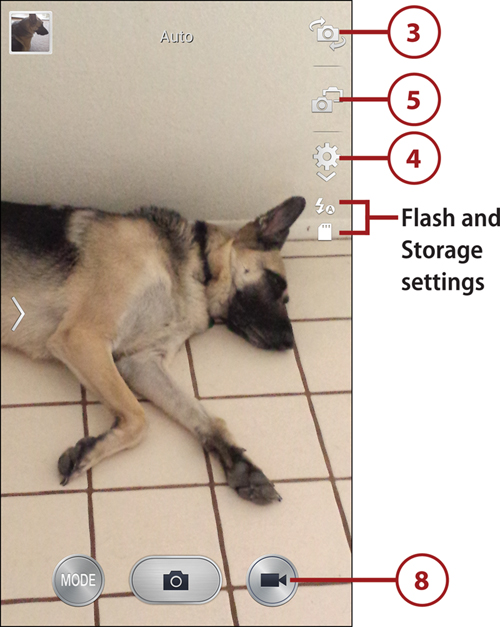
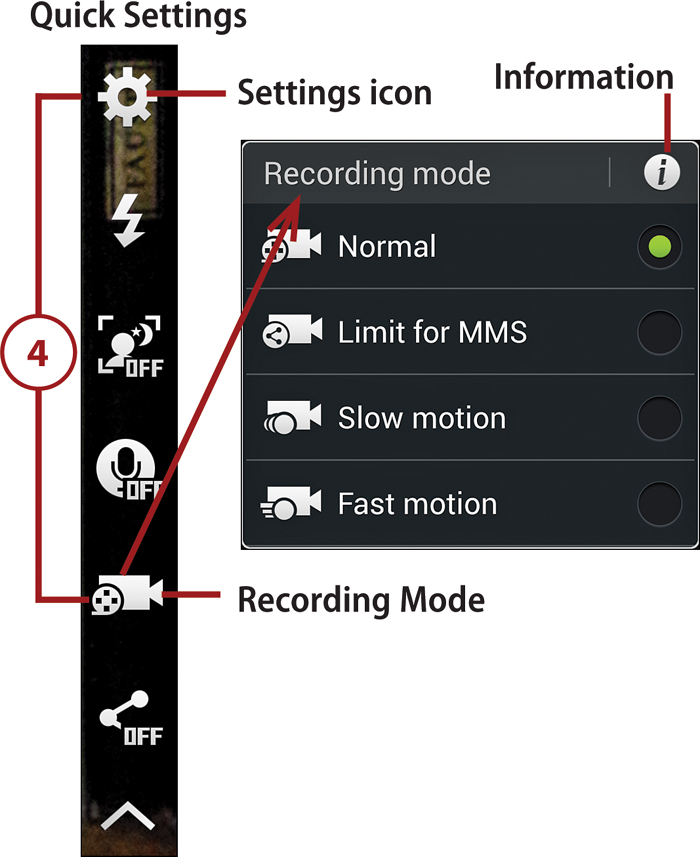
Select a Video Size that’s appropriate for the device on which the video will be played. Each setting specifies the horizontal by vertical dimensions (in pixels). For playback on a flat-screen TV in letterbox format (16:9), select 1920×1080 (16:9) or 1280×720 (16:9), depending on whether the set is capable of displaying 1080 or only 720. Select 1440×1080 (4:3) for television show playback on a 1080-capable flat-screen TV. Select 320×240 (4:3) for playback on the web or for video that you intend to email. Note that the Galaxy S 4 can play videos at any of these resolutions.
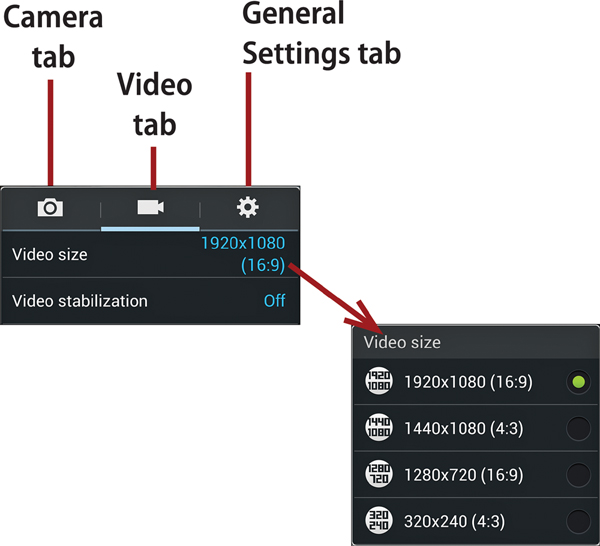
• Storage. The video can be stored in the phone’s internal memory (Device) or on a memory card, if one’s installed. To change this setting, tap the Settings icon twice, select the General Settings tab, and tap Storage.
When you finish making changes, dismiss the menu by tapping anywhere else onscreen or by pressing the Back key.
Dimly Lit Scenes
Although the quality is mediocre, you can shoot in extremely dim or even totally dark settings if you enable Flash in Quick Settings. Flash has three modes: Off, On, and Auto. Repeatedly tap the Flash icon until you see the unadorned lightning bolt (On).
5. Optional: To insert yourself into the recording (using the front-facing camera), tap the Front Camera icon. You can drag the self-recording window to any location. To change the window’s size, tap it and drag the selection handles that appear around the frame.
6. Set the zoom level by pressing the phone’s Volume key, or by placing two fingers on the screen and spreading them apart or squeezing them together. Note that you can vary the zoom level as you record.
7. Set the focal point for the recording by tapping the screen or by dragging the focus rectangle.
8. Tap the Video button to begin recording.
9. During recording, you can temporarily pause by tapping the Pause button. To resume recording, tap the button again. When you finish recording, tap the Stop button. The MPEG-4 video is automatically stored in the DCIM/Camera folder in the phone’s built-in memory or on the memory card, depending on the Storage setting in step 4.
Take a Quick Snapshot
While recording, you can also take photos by tapping the Camera button.
10. If you want to view the resulting video immediately, tap the thumbnail icon in the upper-left corner of the screen. Refer to Chapter 15 for options for sharing your video masterpieces.
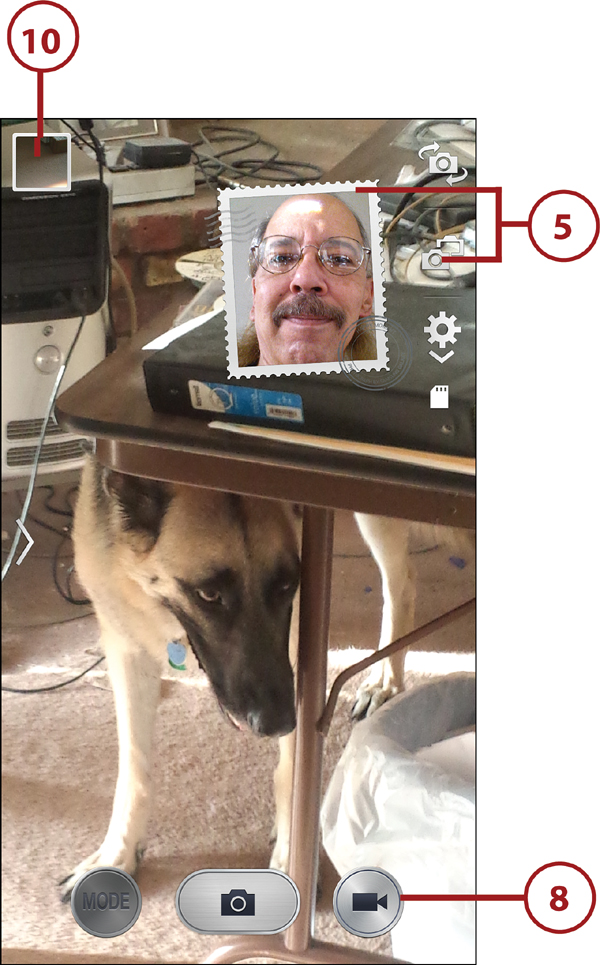
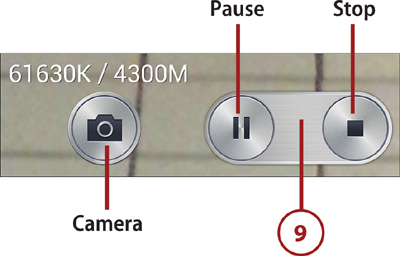
Participating in Video Chats
A final video-related use for your front (and, occasionally, rear) camera is participating in video chats—Internet-based conversations that combine voice and video. Not only can you hear each other, but you can also see the other person’s expressions as he/she talks, as well as what’s happening nearby. Because of the large amount of data exchanged during video chats, they’re best conducted over Wi-Fi or between users who have steady, high-speed connections and unlimited data plans.
To get started with one-on-one or group video chats, launch Google Play (Play Store) and search for video chat. As you read the app descriptions, you’ll note that most require you and your friends to use the same app and be on the same platform: that is, Android, not Apple’s iOS. Some apps also let you connect to desktop or tablet versions of the app. Regardless, to test any of the apps (other than those that permit uninvited chat requests from strangers), you need someone willing to download and try them with you.
